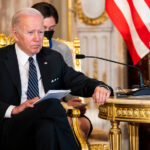LONDON — It has been three months since Russia began its brutal invasion of Ukraine, which Russian President Vladimir Putin hailed as a “special military operation” in order to “de-Nazify” its neighbor. Putin claimed he wanted to “protect” people in the Russian-backed separatist region of Donbas in eastern Ukraine who, the Kremlin leader said, “for eight years now, had been facing humiliation and genocide perpetrated by the Kyiv regime.”
On Feb. 24, Russian soldiers entered Ukraine from the occupied Crimea and Donbas regions, as well as Russia and Belarus from the north. Explosions were heard in major cities around the country, including the capital, Kyiv. Kremlin-led forces focused on seizing the Chernobyl nuclear plant as well as airports and air bases.
While Ukrainian civilians were kept safe in underground bunkers in cities now under martial law, President Volodymyr Zelensky updated the population every night, showing resilience against enemy forces — and three months on, he continues to address the nation each night with a public address.
How has the world reacted?
As days continued into weeks, world leaders took action by imposing sanctions against Putin and his inner circle. Brands such as Nike and companies like Unilever and IKEA halted imports and temporarily closed stores in Russia. McDonald’s and Starbucks have exited Russia for good.
Both Finland and Sweden have applied to join NATO, the military alliance that purportedly prompted Putin to invade Ukraine in the first place — he said he was trying to halt NATO’s expansion in the east.
Despite Ukraine’s being repeatedly denied membership to NATO and the European Union, its Western allies have supplied the country with billions of dollars’ worth of munitions and aid. On Thursday, U.S. lawmakers announced yet another package to Ukraine, worth $40 billion.
Ukrainian troops kept Russians out of Kyiv and Kharkiv, forcing them to refocus their shift to the east. Some Ukrainians have even returned to their homes in those areas, much of which has been liberated.
Massacre in Bucha
But it was when troops retreated from the areas surrounding the capital that the reality of the war was seen in plain sight. In the city of Bucha, 1,000 bodies were found — including at least 31 children. Photo evidence emerged showing corpses lining the streets, with some people shot at point-blank range and others with their hands bound behind their backs. One mass grave held the bodies of 280 local residents, and Ukraine recently claimed that a 1-year-old boy died after he was allegedly raped by Russian soldiers.
President Biden called for a war crimes trial against Putin, with the U.S. State Department deeming the horrifying acts not as an individual instance but rather “part of a broader, troubling campaign.” And although Putin has yet to be formally charged, a 21-year-old Russian soldier named Vadim Shishimarin pleaded guilty last week to war crimes after killing an unarmed man and was sentenced to life in prison.
The siege of Mariupol
The major port city of Mariupol fell into Russian hands months into the invasion, and on Friday Russian officials claimed they had full control of the city. Nearly 1,800 troops who were held up in the Azovstal steel plant were evacuated last week and taken to prison colonies near the city. The International Committee of the Red Cross said it had gathered personal information from the soldiers and registered them as prisoners of war as they left the steelworks.
Ukrainian officials expressed hope for a prisoner exchange, with Zelensky saying he was working to ensure that “the most influential international forces are informed and, as much as possible, involved in saving our troops.”
Ukraine’s human rights ombudsman, Lyudmyla Denisova, said on Telegram that Russia’s military was holding more than 3,000 civilians from Mariupol in a former penal colony in the Donetsk region.
Since Feb. 24, more than 7.1 million Ukrainians have been internally displaced, while 5 million people have fled Ukraine as refugees, the United Nations Refugee Agency reported. In total, nearly 18 million people are estimated to have been affected due to the war — almost half the population of Ukraine.
Intensified attacks in the Donbas region
In the past week, Russian forces have increased their offensive in the Donbas region — encircling the cities of Sievierodonetsk, Lysychansk and Rubizhne. But according to British military intelligence, the offensive is being met with fierce resistance. The U.K.’s Ministry of Defense said that the operation is “separated by approximately 25 km [15 miles] of Ukrainian-held territory” and that the resistance is “occupying well-dug-in defensive positions.”
On Sunday, Ukraine’s Parliament voted to extend martial law and the mobilization of its armed forces until Aug. 23.
What do the next 90 days look like?
Yahoo News spoke to Matthew Schmidt, the director of international affairs and an associate professor of national security at the University of New Haven in Connecticut, about what lies ahead in the next three months.
After an “enormous” amount of soldier casualties — Schmidt estimates around 12,000 losses — Russia has depleted its combat effectiveness. In a bid to continue their attacks against Ukraine, surviving members from different units have been put together, creating a personnel crisis.
So for the next three months, Russia will be focusing on training soldiers quickly and getting them to the frontlines. However, Schmidt believes this will be unlikely, as the “Frankenstein” units made up of the surviving troops will have to secure the frontlines for “90 days or more” against Ukraine’s military, which he says is currently the best military in Europe after NATO’s.
For the Russian military, the next three months will be spent “trying to set up their defense in time,” while the Ukrainians “try to punch it through in time.” The Russians will attack as many enemy soldiers as they can in order to “break Ukrainian combat effectiveness.”
And regarding the future of Ukraine and Russia, Schmidt said it would be impossible to say, as war is the “realm of chaos.”




